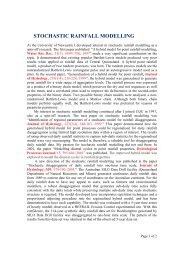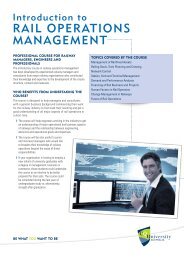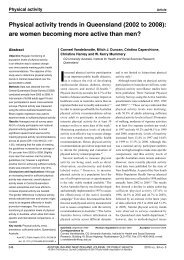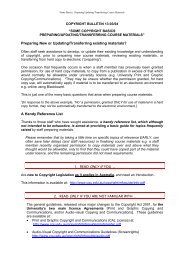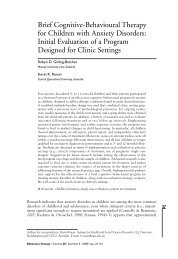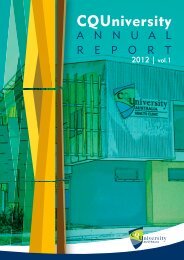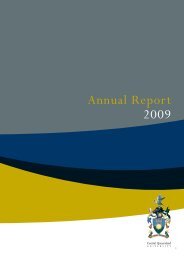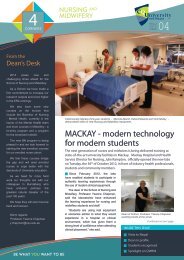2007 Annual Report - Central Queensland University
2007 Annual Report - Central Queensland University
2007 Annual Report - Central Queensland University
You also want an ePaper? Increase the reach of your titles
YUMPU automatically turns print PDFs into web optimized ePapers that Google loves.
<strong>2007</strong> Centre for Plant & Water Science <strong>Annual</strong> <strong>Report</strong>Section H RESEARCH REPORTSOXYGATION INFLUENCES EXPRESSION OF AQUAPORIN GENES UNDERSALINE ENVIRONMENTSSUMMARYOur previous research suggested that the positive response to oxygation (using aerated water forsubsurface drip irrigation) by plants is mediated through root processes. Water flow through plantliving tissues follows apoplastic, symplastic or transcellular paths. Aquaporins are membrane intrinsicprotein pores that can facilitate diffusion of amounts of water along trans-membrane water potentialgradient. Roots can finely adjust their hydraulic conductivity in response to hypoxia and aquaporinscould potentially account for such regulations. A significant part of root water transport (20-80%) isunder rapid metabolic control, and involves the activity of celluar proteins, most likely aquaporins.Therefore, aquaporins may be involved in a large number of physiological functions in plants. Plantaquaporins are divided into four groups based on amino acid sequence similarities: plasma membraneintrinsic proteins (PIPs), tonoplast intrinsic proteins (TIPs), nodulin-like intrinsic proteins (NIPs) andsmall basic intrinsic proteins (SIPs). Some groups may be subdivided again, as is the case with PIPproteins (divided into PIP1 and PIP2). In the current experiment we studied the expression of rootaquaporins genes in order to evaluate the involvement of water channel protein (aquaporins) formediating an enhanced root process during oxygation.The experiment was conducted at the World Vegetable Centre, Shanhua, Taiwan. Root samples werecollected from capsicum, tomato and bean plants grown in aerated and non-aerated non-circulatinghydroponics with (+500 ppm) and without salinity in the solution in a glasshouse from October <strong>2007</strong> –January 2008. Hyponex water soluble complete fertilizer was applied as 1 g L -1 (Scott Fertilizer, USA)throughout the growing season. Salt (NaCl) treatment commenced 3 weeks after seeding. Root and leaftissues were harvested fortnightly and transferred to liquid nitrogen and stored at −70°C prior to theassays. Oxygen concentration of the nutrient solution was monitored with FIBOX-3 and fibre-opticoxygen minisensors. RNA from roots and leaves was isolated as described by Eggermont et al (1996) inthe Trizol reagent. DNase treatment was carried out following the protocols by Goldbeter and Koshland(1981). Reverse transcription (RT) was performed using MMLV reverse transcriptase from Invitrogenefollowing Sambrook et al., (1989). Optimization of primer concentration by used 125 nMconcentrations. Real time rt-PCR protocol of Rotor-Gene 6000 was used to amplify segments ofaquaporin and Na + /H + transporter genes. Using cDNA from capsicum roots as the template, one segmentof each of the PIP and TIP genes was amplified by PCR. Primer sequences are given in Table 1. RACE-PCR with cDNA from capsicum roots provided segments containing the 3-non-translated region ofmembers of the PIP and TIP aquaporin gene families. Together with the primers RACE1, RACE2,RACE3, the gene specific primers PMA and PM1 yielded LePIP1 (AY725511, new PCR-product),PMAand PM2 LePIP2 (BT014251) and TPAand TP1 LeTIP (AY731066, also new PCR-product). Forthe Na + /H + transporter genes, the primerpair ISO1/ISO11 was used with capsicum root cDNA as atemplate for amplifying LeNHX1 (AJ306630) and ISO2/ISO22 for LeNHX2 (AJ306631).Quantification of the mRNA by real-time rt-PCR was performed for the gene of interest in a Rotor Gene6000 The primers in real-time PCR were TRP1: TCA TTC GTG GAG GAT TGG CT and TRP2: ACACTG TTG AAG ACT TGT TCT TCT TTC TTC T. Standardization for this amplificate was performedagainst the 18S-rDNA using the primers 18S-1: GAT GCG CTC CTG GCC TTA AT and 18S-2: TACAGA GCG TAG GCT TGC TTT. The internal control was the tomato ubiquitine.Oxygation increased oxygen concentration of the solution and the difference in oxygen concentrationbecame more prominent during the night (Figure 1). Oxygation of the saline solution significantlyincreased plant dry biomass, number of fruits per plant and reduced the concentration of sodium andchloride concentration in the leaf tissues. Oxygation demonstrated a significant effect on root ability toexclude the salt compared to the non-aerated hypoxic environment (Table 1). The molecular datarevealed that the expression of aquaporin genes such as LePIP2, and LeTIP as well as sodium hydrogen25





